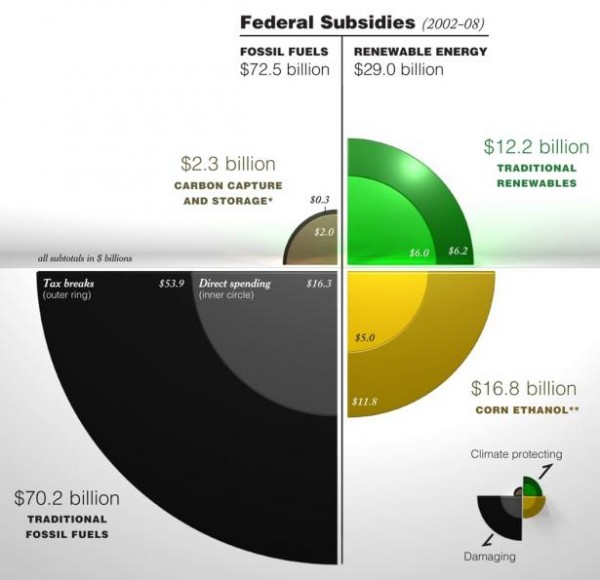The Role of Subsidies on the Path to Energy Self-Sufficiency

If the U.S. is to become energy self-sufficient in future decades, are there strategies in place at the federal level in order to reach that goal? The Obama Administration has called for increasing renewable sources of domestically produced energy to 80% by 2035. Do current federal subsidies increasingly show support for this transition to greater renewable energy use?
Renewable energy sources currently account for 14.3% of domestically produced energy in the United States according to the U.S. Energy Information Administration. Renewable energy technologies, listed by the U.S. Department of Energy, include biomass, geothermal, hydrogen, hydropower, ocean, solar, and wind.
Currently the greatest contributor to the U.S. renewable energy output is hydropower. In 2008 nearly 70% of total renewable energy in the U.S. was derived from hydropower. However, the nation is fast approaching the limit of new sources of waterways available for hydropower reclamation, and the emphasis is moving towards new alternatives.
These alternative forms of renewable energy, including wind and solar, show the most promise for growth if given available funding and emerging technologies to develop further. This is reflected by the amount of subsidies allocated to them. In the fiscal year 2010, wind energy received $4.986 billion in subsidies, the most for a renewable source. Solar came in second, receiving some $968 million. Interestingly, fossil fuel and nuclear energy received $6.677 billion in subsidies in the same year, according to the Institute for Energy Research.
A study conducted by the Environmental Law Institute found that from the years 2002 to 2008 fossil fuel subsidies totaled $72.5 billion. During the same years, renewable energy sources received $29 billion. Of this $29 billion, more than half was attributed to ethanol production. Ethanol subsidies have been criticized, because studies have concluded that the amount of fossil fuels needed in the production of ethanol exceeds the amount of energy derived from it. This negates any environmental benefits and does little to reach the goal of energy self-sufficiency. The conclusion of the study determined that:
“The vast majority of federal subsidies for fossil fuels and renewable energy supported energy sources that emit high levels of greenhouse gasses when used as fuel.”
It is important to note that subsidies received by renewable energies and fossil fuels consist of both federal subsidies, and tax breaks or incentives. A subsidy, by definition is, “A direct transfer from the taxpayer to the beneficiary.” A tax break, on the other hand, allows the beneficiary to retain their own money. Broken down, the subsidies dollars attributed to fossil fuels derived from tax breaks, such as the Foreign Tax Credit ($15.3 billion) and the Credit for Production of Nonconventional fuels ($14.1 billion). This leaves the amount of direct federal subsidies for fossil fuels at $42.6 billion.
The U.S. Department of Energy states on its website that:
“Renewable energy technologies have the potential to strengthen our nation's energy security, improve environmental quality, and contribute to a strong energy economy.”
How the Federal government reorganizes its allocation of subsidies and tax breaks will undoubtedly help to determine how quickly and successfully renewable energy will replace fossil fuels in the future.





